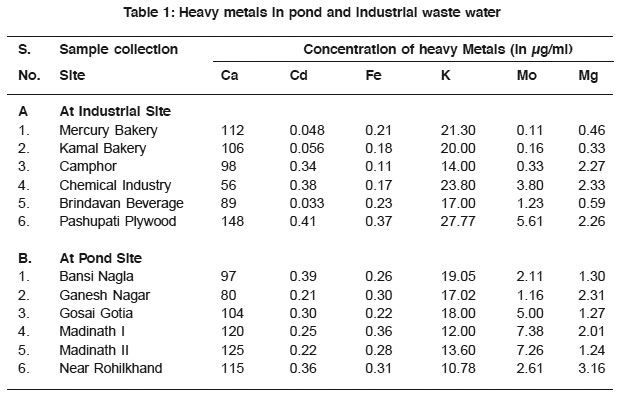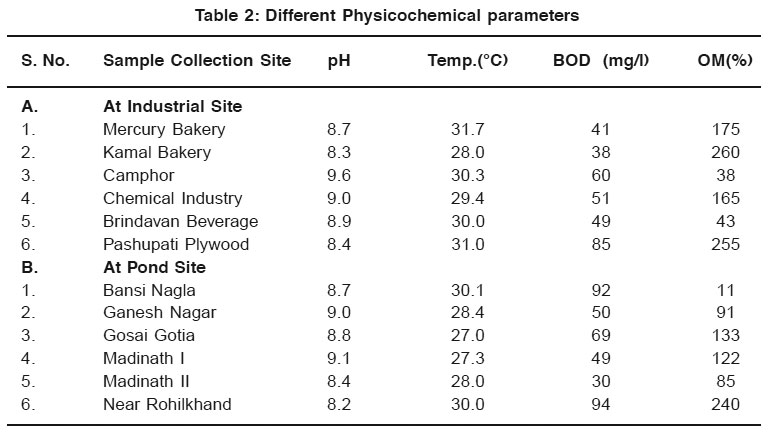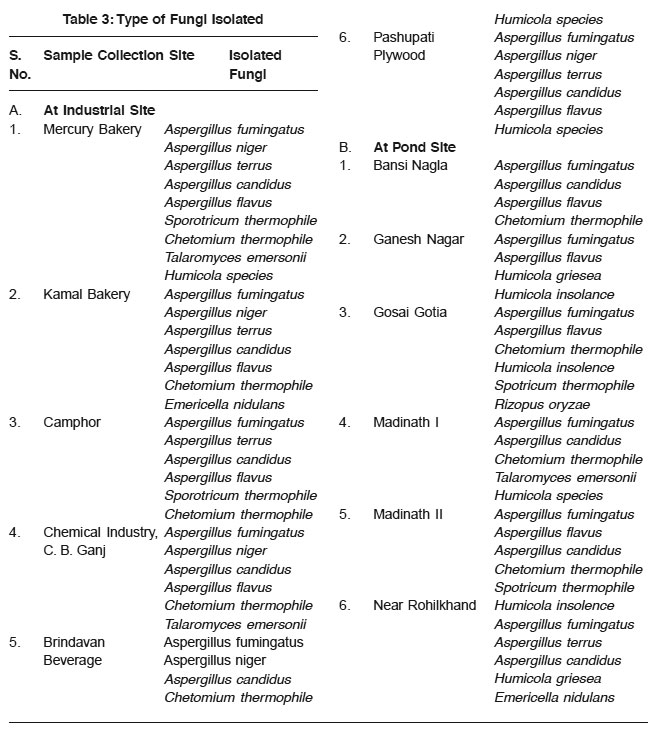Analysis of waste water from different waste water systems
Hashi Yadav1 * , Chandraprabha 1 , A. K. Jaitly1 , Laksyaveer Singh2 , M. Bansal3 and Shiv k Gupta3
1
Department of Plant Science,
M. J. P. Rohilkhand University,
Bareilly,
243 005
India
2
Department of Pharmacy,
M. J. P. Rohilkhand University,
Bareilly,
243 005
India
3
R.V. Northland Institute, 18 km on Gaziabad - Bulandshahar G. T. Road,
Dadri (Greater Noida Phase-II), G. B. Nagar (U.P.),
203 207
India
DOI: http://dx.doi.org/10.12944/CWE.3.1.33
The environment, in which organism exists, has a profound effect on the behavior of organism. Temperature and pH are the two major abiotic factors governing the growth and activity of microbes. Microbes secrete number of degrading enzymes to degrade waste products. The microbes also have the ability of sorption the pollutants like heavy metals. Present works shows the analysis of microbes present in different environment of waste water of many industries and ponds. The fungal flora present in this waste water was incubated and isolated. Industrial water samples showed the pH range of 9-9.6, whereas the pond water sample showed the pH range of 7.5-8.8. High percentage of the organic matter was obtained in pond water (0.134%) as compared to industries waste water (0.045%). Industrial waste water showed the high Ca+2 metal concentrations. The maximum number of fungal species (Aspergillius candidus, A. terres, A. fumigatus, Humicola species and Talaromyces emersonii) were isolated from pond water because of high organic matter (in %) and low pH as compared to industrial waste water.
Copy the following to cite this article:
Yadav S, Chandraprabha, Jaitly A.K, Singh L, Bansal M, Gupta S.K. Analysis of waste water from different waste water systems. Curr World Environ 2008;3(1):203-206 DOI:http://dx.doi.org/10.12944/CWE.3.1.33
Copy the following to cite this URL:
Yadav S, Chandraprabha, Jaitly A.K, Singh L, Bansal M, Gupta S.K. Analysis of waste water from different waste water systems. Curr World Environ 2008;3(1):203-206. Available from: http://www.cwejournal.org/?p=811
Download article (pdf)
Citation Manager
Publish History
Select type of program for download
| Endnote EndNote format (Mac & Win) | |
| Reference Manager Ris format (Win only) | |
| Procite Ris format (Win only) | |
| Medlars Format | |
| RefWorks Format RefWorks format (Mac & Win) | |
| BibTex Format BibTex format (Mac & Win) |
Article Publishing History
| Received: | 2008-03-12 |
|---|---|
| Accepted: | 2008-03-17 |
Introduction
The efforts to supplement available water resources in many parts of the world have resulted in the increased use of effluents for irrigation. In areas where fresh water is limited, the use of effluents for agricultural purpose has been in common practice in the last few decads.1 One of the potential side effects of this practice is long term deterioration of ground water quality, as this effluent contains characteristics ionic composition, high organic matter and pH.
The treated waste water contain higher concentration of suspended and dissolve organic and inorganic matter compared with fresh water. The diversified abiotic factor like dissolved organic matter, ionic strength and its composition as well as pH has a degree of impact on inhabiting mycoflora and fauna, which intern may affect the utility of waste water for irrigation and recycling. Waste water bodies may also contain heavy metals, which may present adverse affect on the growing vegetation. Therefore, the present study has been under taken to look into the physicochemical factors of the waste water and the natural water system of the Bareilly and neighborhood region. The impact of the ecological factors on growing mycoflora of the habitat has been observed and results are presented in this paper.
Experimental
Isolation and Identification
Water samples were aseptically collected from different industries and ponds of Bareilly and nearby region. Samples were analyzed for their fungal species by direct and dilution-plate method, using yeast powder soluble starch (YpSs) medium. The Petri plates were incubated at 45 ± 1°C for the growth of thermophilic fungi and were observed after two days.
Method
Waste water samples were aseptically collected from different industries and ponds of Bareilly. The pH of sample was measured and organic matter was calculated by Walkey & Black method (1947). The percentage of organic mater was calculated by the formula

where,
W = Volume of sample
T = Sample Titration
S = Blank Sample
After this, the thermophilic fungal were isolated from collected waste water samples using the YpSs medium at pH 7 at 45°C (War cup, 1950). Co-relation of the isolated fungal forms was inferred with the different physiochemical properties of the waste water like pH, temperature, BOD and % organic matter. The pH is determined by using Systonic pH system 361, heavy metals (Ca, Cd, Fe, K, Mo & Mg) using ECIL Atomic Adsorption Spectrophotometer, BOD is calculated by using AHPA 2000 (A Standard methods for analysis of water and waste water, American Public Health Association, Washington D.C., 2000.) and Organic matter was determined by Walkey & Black method 1947.
 |
Table 1: Heavy metals in pond and industrial waste water Click here to view table |
Results
Table 1 summarizes the concentration of different heavy metals present in samples collected from different industrial site and different pond sites of water in the Bareilly region. Table 2 describes different physicochemical parameters like pH, temperature, BOD and % organic matter at different pond and industrial sites. Table 3 shows the type of different species of fungi isolated from the collected samples of waste water from different sites.
 |
Table 2: Different Physicochemical parameters Click here to view table |
The result showed that the amount and types of fungi isolated was very much higher in the samples collected from pond site than that collected from the industrial site.
 |
Table 3: Type of Fungi Isolated Click here to view table |
Discussion
The current work indicates that the maximum species of the enzymes were obtained from the fungus isolated from the water samples collected from the pond sites rather then the fungus isolated from the water samples collected from the industrial sites. This is due to the high concentration of the heavy metals, biological organic matter, pH, organic matter, etc. which are favorable for the growth of the fungi.
Industrial water samples showed the pH range 9-9.6 and pond water sample showed the pH range 7.5-8.8. A High percentage of the organic matter was obtained in pond water 0.134% while in industries waste water was only 0.045%.Industrial water and pond water showed a high concentration of Ca+2 metal. The maximum numbers of fungal species were isolated from pond water because of high Organic matter and low pH. Highest % of organic matter was obtained in the pond water 0.134 % while it was 0.045 in the industrial water and portable water has neglectable value of organic matter.
Conclusion
From the present study, we can conclude that the waste water obtained from the different industrial sites of the Bareilly region is less polluted then that of the environmental condition facing pond water.
References
- Rebhun M., Goodman N.L. and Barker F.B., J. Water Pollution Control Fed, (1987) 59: 242-248.
- Grabber E.R, G.C. Fischer, and U. Mingeigrin. Soil Sci. Soc. Am. J., (1995) 59: 1513-1519.
- Hutchins S.R., Tomar M.B., Bedient P.B. and Ward C.H., CRC Crit. Rev. in Environ. Control, (1985) 15: 355-413.
- Muszkat L., Raucher D., Magaritz M., Ronen D., and Amiel A.J., Ground Water (1993) 3: 556-565.
- Imai A., Fukushima T., Matsushige K., Kim Y.H., and Choi K., Water Res. (2002) 36: 859-870.
- Loukidou M.X., Matis K.A., Zouboulis A.T., Liakopoulou K.M., (2003) 37(18): 4544-4552.
- Ronen D. and Magaritz M, J. Hydrol. (1985) 30: 311-323.
- Warcupc J.H., Nature (London) (1950) 166: 117-118.






